20 Fascinating Photos Of Concerts From ’60s, ’70s And ’80s
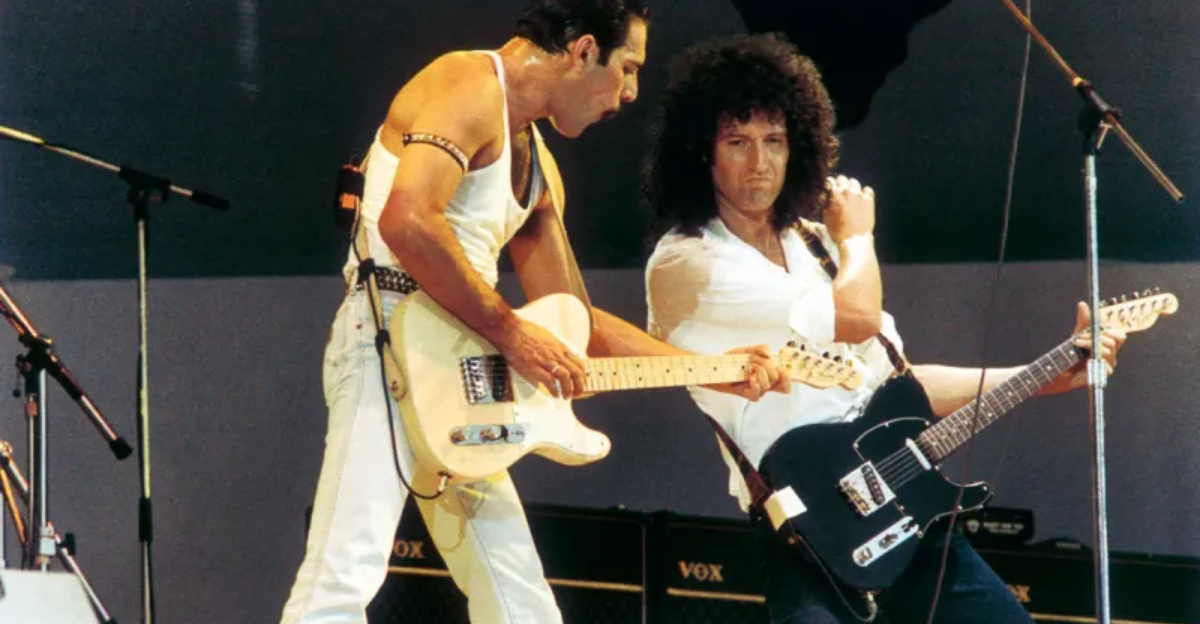
Concerts in the ’60s, ’70s, and ’80s weren’t just about music—they were full-blown cultural events that shaped generations and left a lasting impact on society.
These were the days when live music ruled supreme, and artists didn’t just perform—they transformed the stage into a place of magic, rebellion, and unforgettable expression. Think of the electrifying solos of Jimi Hendrix at Woodstock, or the explosive energy Freddie Mercury brought to every Queen performance.
These concerts weren’t just shows; they were communal experiences, moments of unity, passion, and identity. From political statements to fashion revolutions, each event echoed far beyond the music itself. With every photograph and story, we get a glimpse into an era when talent, emotion, and authenticity were the heartbeat of live shows.
Join us as we revisit 20 legendary concerts that captured the spirit of their time and continue to inspire fans across the world today.
1. The Beatles at Shea Stadium (1965)
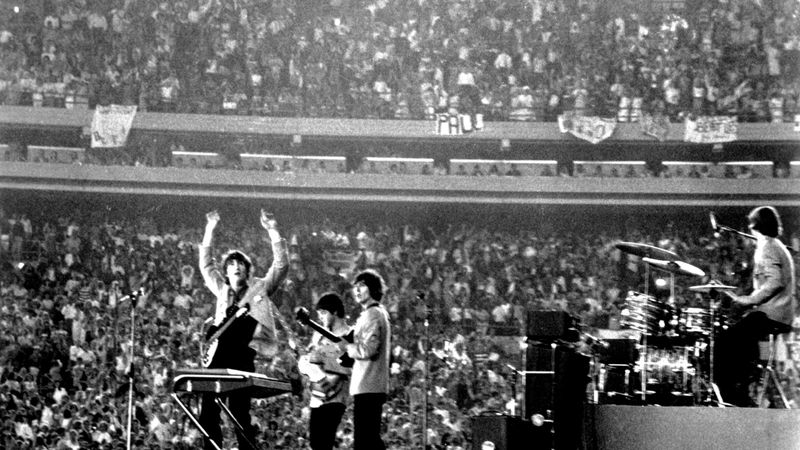
Beatlemania reached its peak at Shea Stadium in 1965. Picture this: The Fab Four, barely in their twenties, took the stage before an audience of 55,000 ecstatic fans. The screams were so deafening that even The Beatles themselves couldn’t hear their own music—a historic chaos indeed! George Harrison once quipped that the fans were so loud, “they could have been playing ‘Three Blind Mice’ and nobody would have noticed.” It was the epitome of ’60s rock hysteria, with girls fainting and everyone caught up in the Beatle fever. The concert set the standard for stadium rock shows and proved that The Beatles were more than a band; they were a movement.
This event was a milestone that showcased the power of live music to unite people. The energy in the air was electric, a tangible buzz that connected strangers in shared awe. To think, it all unfolded in a venue typically reserved for baseball games! Shea Stadium became a symbol of rock ‘n’ roll’s unstoppable rise.
A moment in time when music transcended, and history was made, leaving behind an unforgettable legacy that resonates through generations.
2. Jimi Hendrix at Monterey Pop Festival (1967)
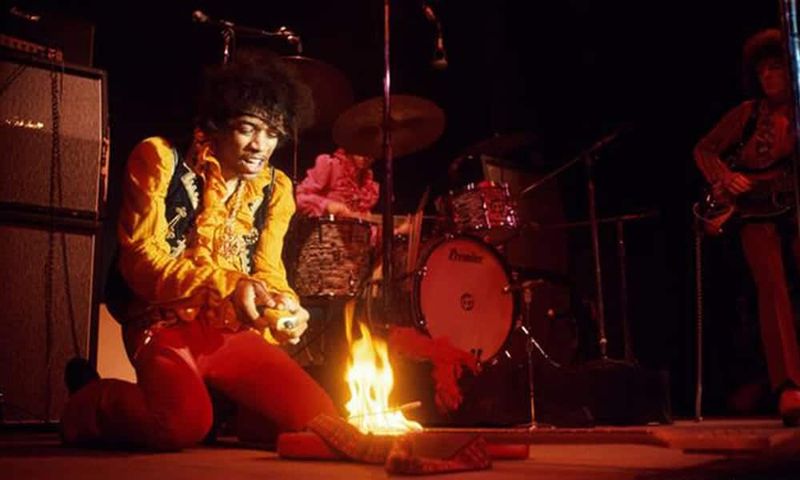
Jimi Hendrix took the stage at the Monterey Pop Festival in 1967, and let’s just say, he didn’t just play the guitar—he set it on fire. Literally. The crowd watched in awe as this guitar god, barely in his mid-twenties, conjured pure magic with his strings, culminating in the iconic sight of flames licking the body of his guitar. This wasn’t just a performance—it was a rite of passage, a star-making moment that catapulted Hendrix into the stratosphere of rock legends.
Monterey was more than just an audience; it was a witness to a myth in the making. Jimi’s guitar pyrotechnics were symbolic of the explosive energy and passion that defined the counterculture era. This was the ’60s in all its rebellious glory, a time when music was a form of revolution and self-expression knew no bounds.
To cite Jimi’s own words, “Music doesn’t lie. If there is something to be changed in this world, then it can only happen through music.” This unforgettable spectacle is captured in countless photographs, each frame a testament to a moment when rock and roll became art.
3. The Rolling Stones at Altamont (1969)
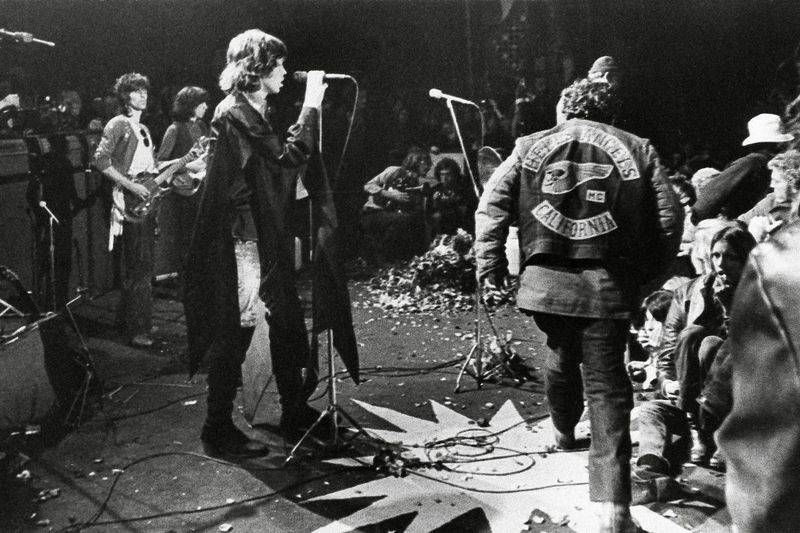
Altamont 1969—a name synonymous with chaos. The Rolling Stones thought they’d throw a free concert in California, but things took a dark turn when they hired Hell’s Angels for security. Picture a scene straight out of a rock ‘n’ roll dystopia, with tension so thick you could cut it with a guitar string. Mick Jagger and the band were in their prime, captivating the crowd while trying to navigate the bedlam.
The concert was meant to be a peaceful celebration, but it ended up as a cautionary tale of what happens when rock meets recklessness. Despite the turmoil, the Stones’ music shone through, a reminder of the band’s resilience and charisma. This event became a symbol of the end of the ’60s peace-and-love era, marking a shift towards a more disillusioned outlook.
Legend has it that the Altamont concert was both a wake-up call and a reflection of the growing pains of the rock scene. It’s a snapshot of a time when the line between music and mayhem blurred, leaving behind an indelible mark etched in rock history.
4. Janis Joplin at Woodstock (1969)
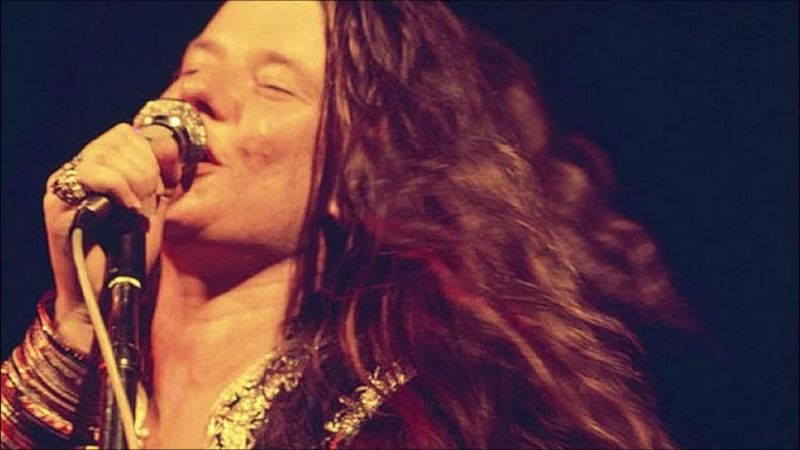
Janis Joplin at Woodstock in ’69—her voice was like a force of nature, raw and raspy, echoing through the fields of Yasgur’s Farm. Imagine standing in that sea of humanity, drenched in the spirit of freedom, as Joplin belted out tunes that were equal parts heart and soul. Janis, in her mid-twenties, embodied the counterculture spirit, a wildflower blooming in the summer of love.
Her performance was a testament to the power of music to move and unite people, transcending the mud and chaos of the iconic festival. She was a hurricane of emotion, a bluesy siren with a voice that could both soothe and electrify. Woodstock wasn’t just a concert; it was a movement, and Joplin was one of its brightest stars.
This was a moment in time when music became a lifeline, a beacon of hope in turbulent times. Janis Joplin’s legacy lives on, her spirit immortalized in photographs that capture the essence of a generation yearning for change. Her performance at Woodstock remains a symbol of the unbridled passion and timeless artistry that defined a decade.
5. Bob Dylan “Goes Electric” at Newport Folk Festival (1965)

In 1965, Bob Dylan stood at the crossroads of tradition and transformation at the Newport Folk Festival. Armed with an electric guitar, he stepped onto the stage and rocked the boat of folk purists. Imagine the scene: Dylan, in his mid-twenties, breaking boundaries with a single strum, as boos mingled with cheers in a cacophony of divided opinions.
It was a moment that redefined music history, when Dylan electrified not just his guitar, but the entire folk genre. His decision to ‘go electric’ was a bold move, an act of defiance that resonated with a generation hungry for change. This was the sound of evolution, a musical revolution that challenged the status quo and paved the way for countless artists to follow.
Dylan’s Newport performance is immortalized in photographs that capture the tension and triumph of that fateful day. It’s a story of courage, of an artist daring to chart a new course and, in the process, forever altering the landscape of popular music. This was a turning point, a moment that proved the power of innovation and the enduring strength of Dylan’s artistic vision.
6. James Brown’s Boston Garden Show (1968)
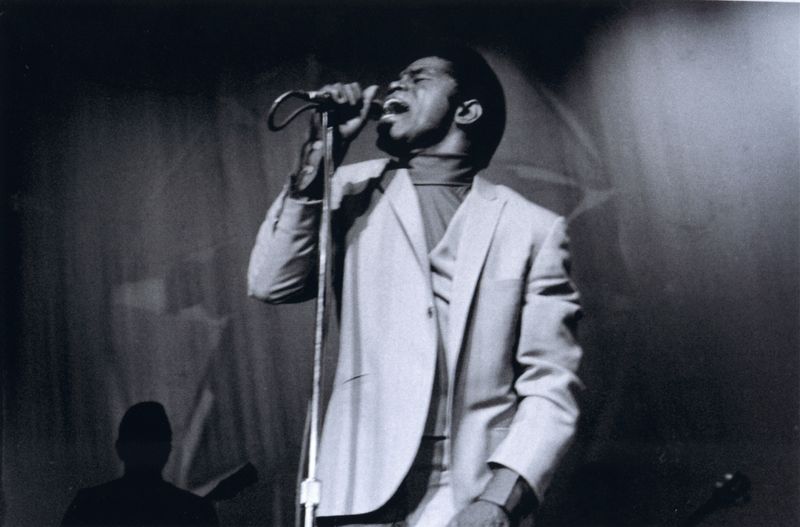
James Brown’s performance at the Boston Garden in 1968 was nothing short of legendary. In the wake of Martin Luther King Jr.’s assassination, the Godfather of Soul took to the stage to calm a city teetering on the brink of chaos. Brown, in his thirties, was more than a musician that night; he was a peacemaker, using music as a balm for a grieving nation.
Picture the scene: a packed arena, emotions running high, and Brown delivering a soul-stirring performance that captivated and united the audience. His music was a powerful force for healing, a reminder of the unifying power of rhythm and blues. This concert was not just about entertainment; it was about community, about coming together in a time of turmoil.
James Brown’s show at the Boston Garden remains a pivotal moment in music history, captured in photos that convey the raw emotion and energy of that night. It’s a testament to the power of music to transcend boundaries and bring people together, proving once again that James Brown was more than a performer—he was an icon.
7. The Who Smashing Instruments on National TV (Smothers Brothers, 1967)
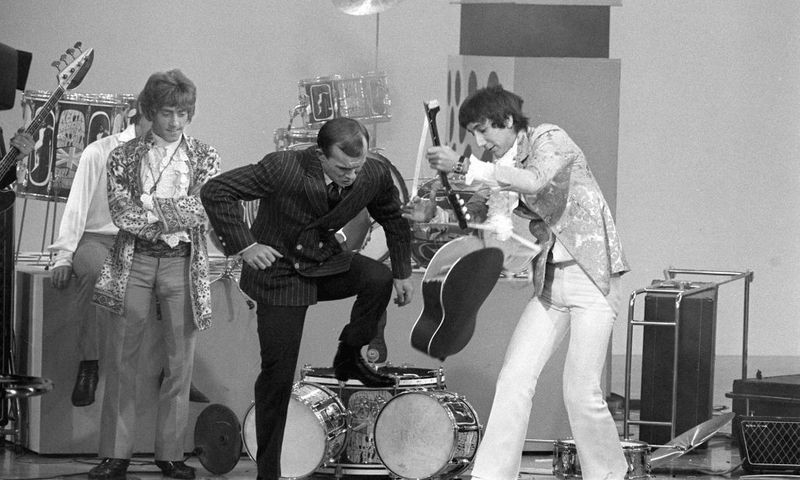
When The Who took the stage on The Smothers Brothers Comedy Hour in 1967, they turned television into a rock ‘n’ roll battleground. Imagine the scene: a young Pete Townshend and his bandmates, in their twenties, unleashing musical mayhem with a ferocity that left instruments—and eardrums—shattered.
As guitars splintered and drums exploded, viewers witnessed a performance that blurred the line between art and anarchy. This was more than just a concert; it was a statement, a declaration that rock music was here to stay, and it wasn’t going to play by the rules. The Who’s televised destruction became a symbol of rebellion, a defiant act that captured the raw energy and unpredictability of the ’60s rock scene.
Photographs of this electrifying moment encapsulate the spirit of a band that dared to destroy in order to create. This was punk rock before punk rock was even a thing—a moment that left an indelible mark on the music world and proved that The Who were true pioneers of performance art.
8. Pink Floyd’s “The Wall” Shows (1979–80)
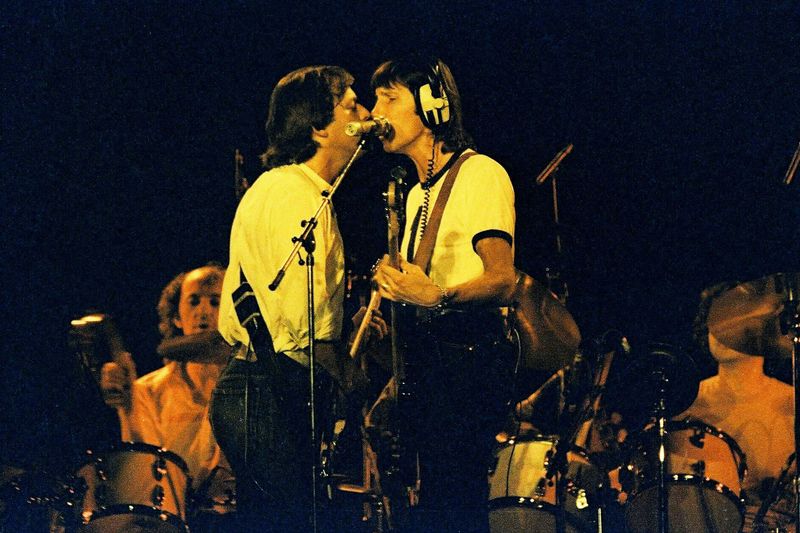
Pink Floyd’s “The Wall” shows from 1979 to 1980 were concerts that redefined the boundaries of live performance. Imagine a stage transformed into a massive, literal wall that was built and knocked down throughout the show. This was more than a concert; it was a rock opera, a theatrical spectacle that captivated audiences with its fusion of music and visual artistry.
The band, with members in their thirties, delivered a performance that was both immersive and innovative, setting a new standard for what a live show could be. The Wall was a metaphor for isolation and alienation, themes that resonated powerfully with the audience and made the concerts not just memorable, but transformative.
These shows are immortalized in photos that capture the grandeur and intensity of the performances. It’s a testament to Pink Floyd’s ingenuity and their ability to push artistic boundaries. The Wall shows remain a pinnacle of live music history, a moment when rock music reached new heights of storytelling and spectacle.
9. Led Zeppelin at Madison Square Garden (1973)
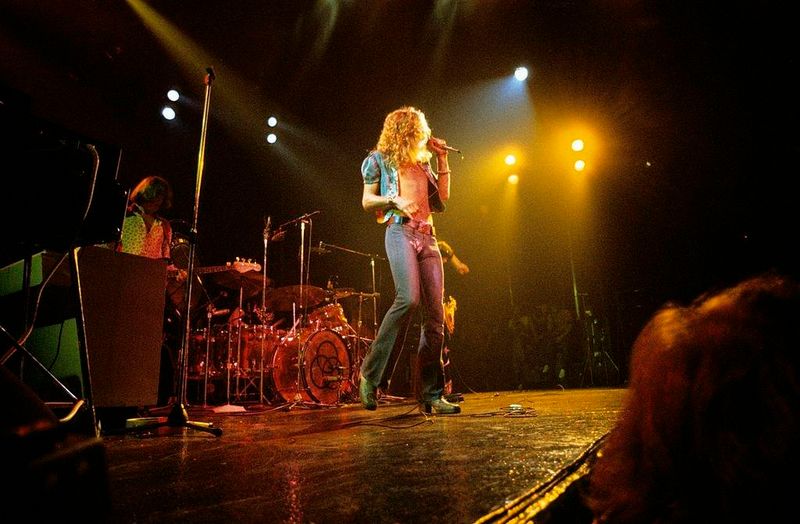
Led Zeppelin’s 1973 concert at Madison Square Garden is the stuff of rock legend. Picture this: Robert Plant and Jimmy Page, in their thirties, commanding the stage with a presence that was larger than life. Their performance, immortalized in the film “The Song Remains the Same,” captured the raw power and charisma that defined Zeppelin’s live shows.
Madison Square Garden was electric, a cathedral of rock where fans gathered to witness a band at the peak of its powers. Zeppelin’s music was a force of nature, with guitar riffs that echoed like thunder and vocals that soared to the heavens. This concert wasn’t just an event; it was an experience, a pilgrimage for fans seeking the holy grail of rock ‘n’ roll.
Photographs of this iconic show convey the energy and excitement that pulsed through the venue. It’s a testament to Led Zeppelin’s status as rock royalty, a band that left an indelible mark on the music world. Madison Square Garden became a sacred space for rock history, a place where legends were born and dreams were realized.
10. David Bowie as Ziggy Stardust (1973, London)
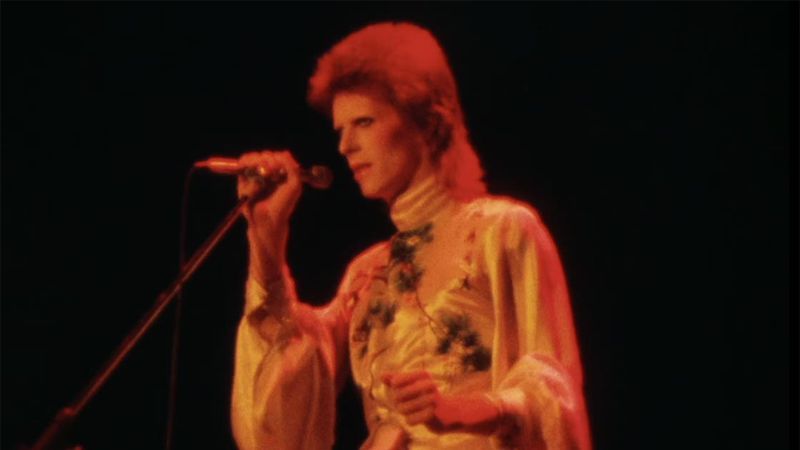
In 1973, David Bowie transformed into Ziggy Stardust, a glam rock alien who took London by storm. Imagine the scene: Bowie, in his mid-twenties, strutting across the stage in outlandish costumes and makeup, a vision of pure theatricality. Ziggy wasn’t just a character; he was a revolution, a reinvention that captivated audiences with its blend of music and performance art.
Bowie’s Ziggy Stardust shows were an explosion of creativity, a kaleidoscope of sound and vision that defied convention. The concerts were more than just music; they were a spectacle, a dazzling display of talent and imagination that pushed the boundaries of what a live show could be.
Photographs of Bowie as Ziggy capture the energy and innovation of this iconic era. It’s a testament to Bowie’s genius, his ability to reinvent himself and shape the future of music. Ziggy Stardust remains one of rock’s most enduring personas, a symbol of individuality and artistic freedom that continues to inspire generations.
11. Fleetwood Mac’s Rumours Tour (1977)

Fleetwood Mac’s 1977 Rumours Tour was a whirlwind of talent, emotion, and behind-the-scenes drama. Picture the band, with members in their thirties, taking the stage amid swirling rumors and interpersonal rifts. Yet, when the music started, nothing else mattered. Their harmonies were flawless, their energy palpable—a testament to their professionalism and passion.
The Rumours Tour was a showcase of Fleetwood Mac’s musical prowess, a celebration of an album that became a timeless classic. The concerts were a cathartic release, a place where the band could channel their personal struggles into powerful performances that resonated with fans. Each show was a reminder of the magic that happens when artists put aside their differences and focus on the music.
Photos from the tour capture the intensity and camaraderie that defined Fleetwood Mac’s live performances. It’s a story of resilience, a band that overcame internal strife to create something beautiful. The Rumours Tour remains a milestone in music history, a testament to the enduring power of Fleetwood Mac’s artistry and the timeless appeal of their music.
12. The Last Waltz (1976)

The Last Waltz in 1976 wasn’t just a concert; it was a celebration, a farewell to The Band with a little help from their friends. Imagine the atmosphere: The Band, alongside legendary musicians like Bob Dylan and Eric Clapton, bidding adieu to the stage in a show directed by Martin Scorsese. It was a night of nostalgia, a fitting tribute to a group that had profoundly influenced the music landscape.
The concert was a gathering of talent, a who’s who of the rock world, each bringing their unique flair to the stage. It wasn’t just about saying goodbye; it was about honoring the legacy of a band that had left an indelible mark on music history. The Last Waltz was a moment frozen in time, a poignant blend of joy and melancholy.
Photographs of the event capture the camaraderie and emotion that filled the room. It’s a reminder of the power of collaboration, of the magic that happens when great artists come together. The Last Waltz remains a landmark in concert history, a tribute to the enduring spirit of The Band and the timeless appeal of their music.
13. Sex Pistols’ U.S. Tour (1978)
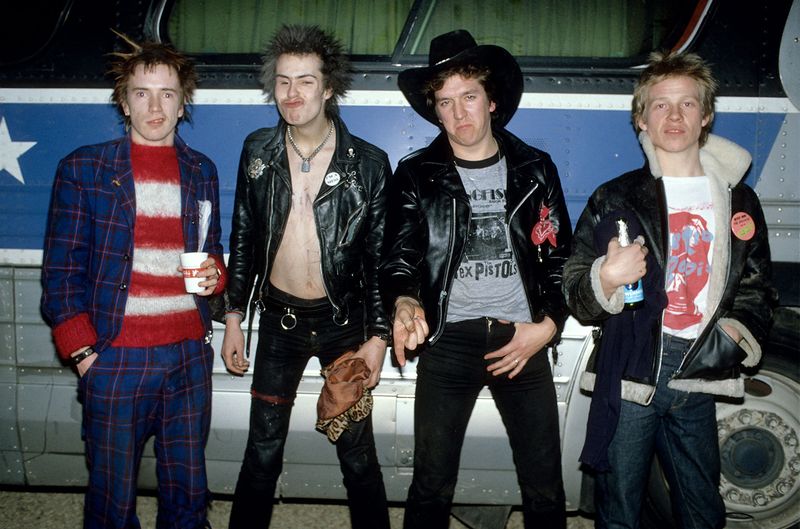
The Sex Pistols’ U.S. Tour in 1978 was a whirlwind of punk rock chaos and rebellion. Picture the band, with members in their twenties, storming the States with a sound that was raw, loud, and unapologetically confrontational. The tour was brief, explosive, and chaotic—a fitting reflection of the band’s ethos.
The Pistols were more than just musicians; they were provocateurs, challenging the norms and shaking up the music scene with their anarchic energy. Each concert was a spectacle, a fusion of music and madness that left audiences both shocked and enthralled. The tour’s implosion was as inevitable as it was iconic, cementing the Pistols’ legacy as punk pioneers.
Photos from the tour capture the intensity and rebellion that defined the Pistols’ live shows. It’s a testament to the band’s impact, a reminder of a time when music was a vehicle for revolution. The Sex Pistols’ U.S. Tour remains a milestone in punk history, a symbol of the raw power and enduring influence of their music.
14. The Grateful Dead at Egypt’s Pyramids (1978)
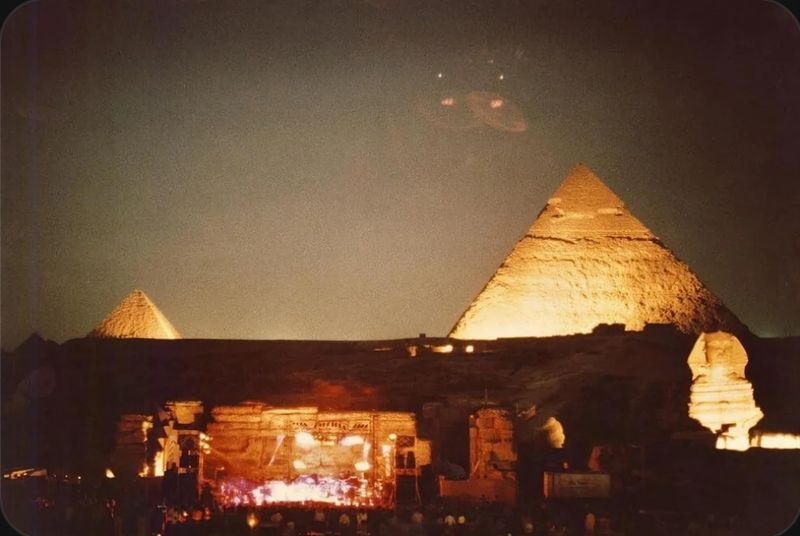
In 1978, the Grateful Dead took their music to new heights—literally—by playing at the base of Egypt’s Great Pyramids. Picture the scene: a band known for their improvisational jams, performing in a setting as ancient as it was awe-inspiring. The desert air hummed with the sound of guitars, creating a mystical atmosphere that was both surreal and transcendent.
The Dead’s Egypt concerts were more than just gigs; they were a cultural exchange, a melding of ancient history and modern rock. The band, in their thirties, was at the height of their creative powers, embracing the spirit of adventure and exploration. This was music as a journey, a pilgrimage to one of the world’s most iconic locations.
Photos from the event capture the magic and mystery of the performances. It’s a testament to the Dead’s willingness to push boundaries and create unforgettable experiences. The Grateful Dead’s Egypt concerts remain a highlight of their storied career, a symbol of the band’s enduring spirit and the universal language of music.
15. Elvis Presley’s Aloha from Hawaii (1973)
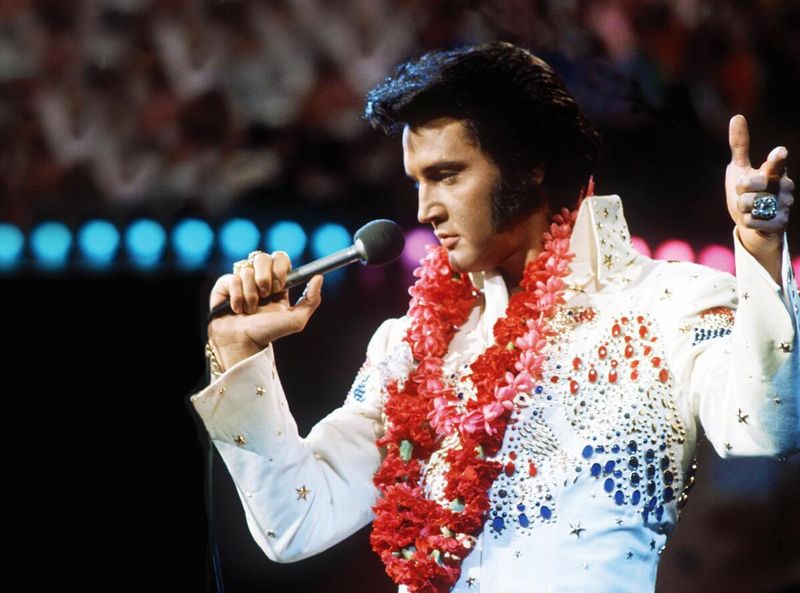
In 1973, Elvis Presley made history with his “Aloha from Hawaii” concert, the first broadcast live via satellite. Imagine the King of Rock ‘n’ Roll, in his late thirties, dazzling a global audience with his charisma and unmatched stage presence. The Hawaiian stage was set, a tropical paradise for a musical milestone that reached millions around the world.
Elvis’s performance was more than just a concert; it was a technological marvel, a fusion of music and innovation that showcased the power of television to unite audiences across continents. The King’s voice was as captivating as ever, his energy palpable as he serenaded fans from a distance.
Photos of the event capture the grandeur and excitement of the performance. It’s a testament to Elvis’s enduring appeal and the groundbreaking nature of the broadcast. “Aloha from Hawaii” remains a landmark in music history, a moment when the King of Rock ‘n’ Roll proved that his reign was truly global.
16. Queen at Live Aid (1985)

Queen’s performance at Live Aid in 1985 is hailed as one of the greatest rock concerts of all time. Imagine Wembley Stadium, filled with a sea of fans, as Freddie Mercury, in his late thirties, takes the stage with unmatched charisma and energy. It wasn’t just a concert; it was a phenomenon, a moment that has been immortalized in film and memory.
With every note, Queen captivated the world, delivering a set that was both powerful and poignant. They brought the stadium to life, uniting a global audience in a shared experience of music and emotion. This wasn’t just a performance; it was an anthem of hope and unity, a reminder of the power of music to bring people together.
Photos from Live Aid capture the electricity and emotion of the event. It’s a testament to Queen’s legacy and the enduring appeal of their music. The Live Aid performance remains a pinnacle of concert history, a moment when Queen truly reigned supreme.
17. U2 at Red Rocks (1983)
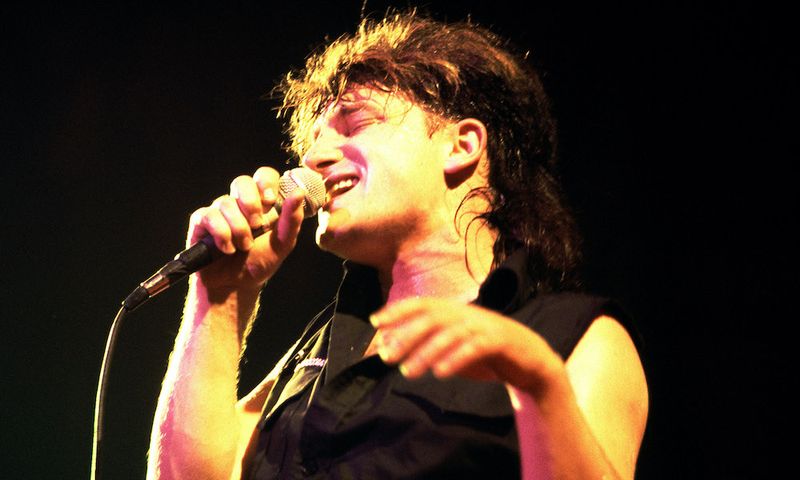
U2’s 1983 performance at Red Rocks is etched in rock history. Imagine a stage set against the natural grandeur of Colorado’s Red Rocks Amphitheatre, shrouded in fog and rain. Bono, in his early twenties, waved a white flag as a symbol of peace, creating an iconic image that resonated around the world.
The concert was more than just a rock show; it was a statement, an embodiment of U2’s message of unity and hope. The atmosphere was electric, the music soaring as the band delivered an unforgettable performance that captured the spirit of the times. This was U2 at their best, combining powerful lyrics with passionate performances to create a moment that transcended the stage.
Photographs of the event capture the magic and intensity of the night. It’s a testament to U2’s impact and the timeless appeal of their music. The Red Rocks concert remains a touchstone in live music history, a moment when the band’s message and music came together in perfect harmony.
18. Madonna’s Blond Ambition Tour (1989–90)
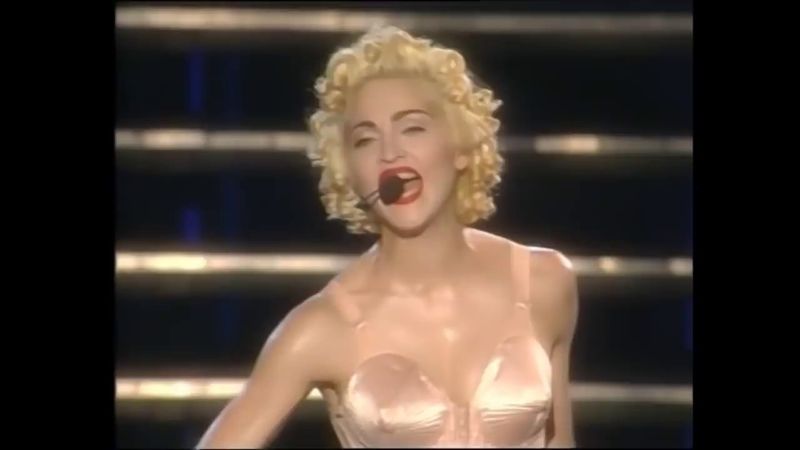
Madonna’s Blond Ambition Tour from 1989 to 1990 was a tour de force of theatricality and controversy. Imagine the Queen of Pop, in her early thirties, commanding the stage with a boldness that redefined the concert experience. Each performance was a meticulously crafted spectacle, a fusion of music, dance, and fashion that pushed boundaries and challenged societal norms.
Madonna’s tour wasn’t just about entertainment; it was about empowerment, a celebration of individuality and self-expression. Her provocative style and unapologetic persona captivated audiences and left an indelible mark on the music world. This was more than just a concert; it was a cultural statement, a declaration of independence that resonated with fans around the globe.
Photos from the Blond Ambition Tour capture the energy and creativity of Madonna’s performances. It’s a testament to her influence and the transformative power of her music. The tour remains a landmark in pop history, a moment when Madonna cemented her status as a trailblazer and icon.
19. Metallica’s Damaged Justice Tour (1988–89)
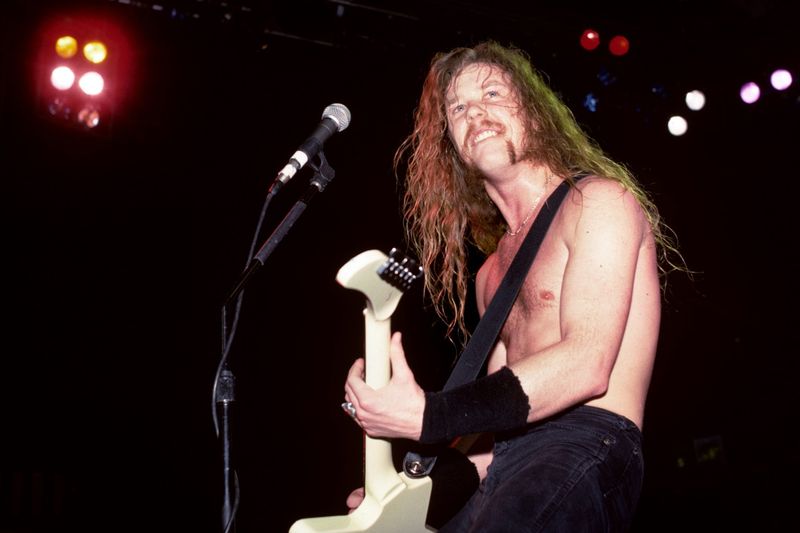
Metallica’s Damaged Justice Tour from 1988 to 1989 was a metal milestone, a tour that shredded across continents with unrelenting energy. Picture the band, with members in their twenties, dominating the stage with a sound that was as heavy as it was exhilarating. Each performance was a sonic assault, a testament to Metallica’s power and precision.
The tour wasn’t just about music; it was a declaration of metal’s rise, a celebration of raw energy and technical prowess. Metallica’s live shows were legendary for their intensity, a combination of blistering riffs and thunderous rhythms that left audiences breathless. This was a time when metal was more than a genre; it was a movement, a force that united fans around the world.
Photos from the Damaged Justice Tour capture the intensity and excitement of Metallica’s performances. It’s a testament to the band’s impact and the enduring influence of their music. The tour remains a landmark in metal history, a moment when Metallica cemented their status as titans of the genre.
20. Talking Heads’ Stop Making Sense Tour (1983–84)
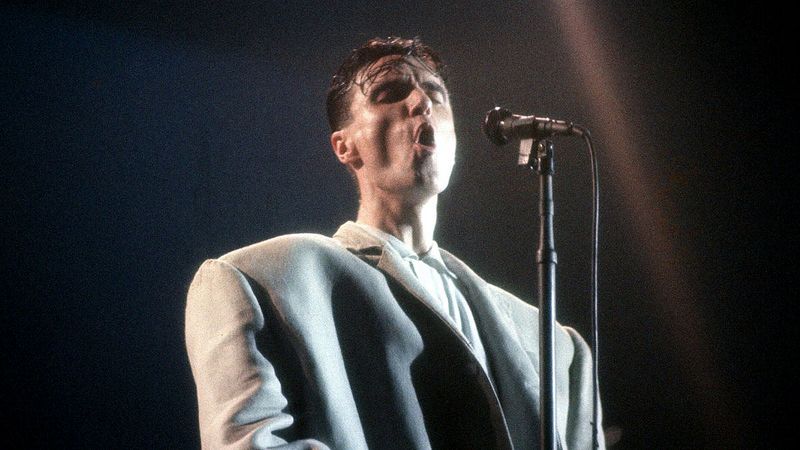
The Talking Heads’ “Stop Making Sense” Tour from 1983 to 1984 was a groundbreaking blend of music, art, and innovation. Picture David Byrne, in his early thirties, donning a giant suit as he danced across the stage, creating an iconic image that became synonymous with the band’s unique style.
This wasn’t just a concert; it was a performance art piece, a fusion of visual creativity and musical genius that captivated audiences. The tour was a celebration of the band’s eclectic sound and their ability to transcend conventional concert norms. It was a reminder that music could be both entertaining and thought-provoking, a medium for artistic expression.
Photographs of the performances capture the energy and creativity that defined the tour. It’s a testament to the Talking Heads’ influence and the lasting impact of their music. “Stop Making Sense” remains a landmark in concert history, a moment when the band redefined what a live show could be.
